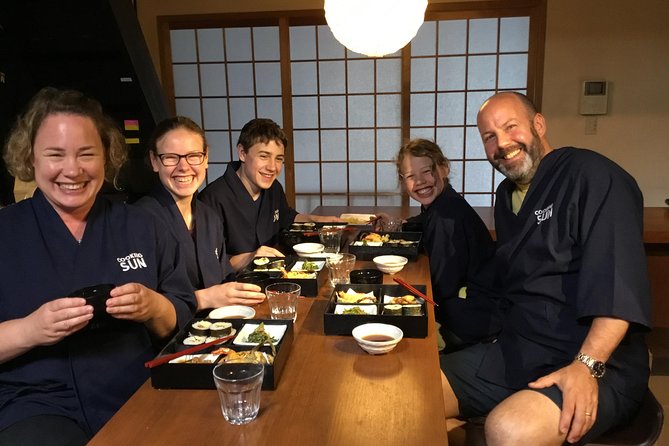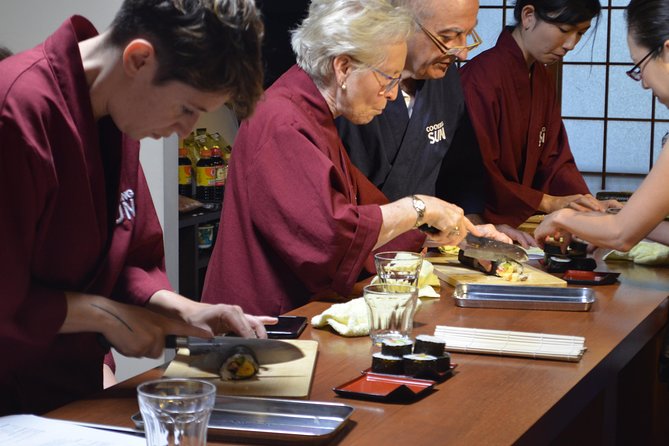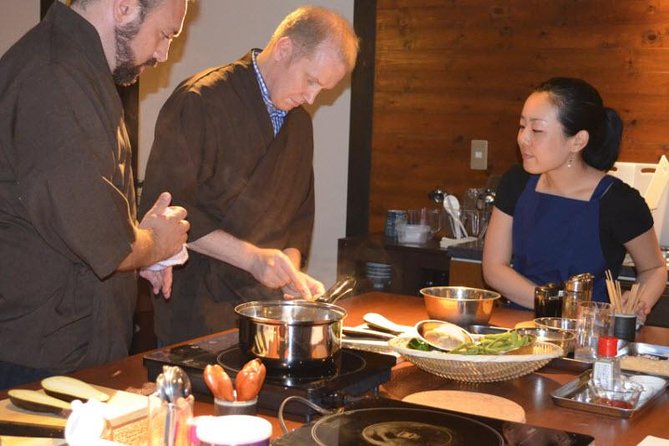Bento boxes are a quintessential part of Japanese culinary culture, offering a delightful balance of flavors and visual appeal. A cooking class dedicated to this art form promises an immersive experience for those eager to explore its nuances. Over several hours, you will master the techniques behind crafting these portable meals, from preparing the individual components to artfully arranging them. By the end of the session, guests can savor the fruits of their labor – a beautifully presented bento box that embodies the harmony of Japanese cuisine. It’s an opportunity to not only learn but also appreciate the centuries-old tradition that has captivated foodies worldwide.
Key Points

- The cooking class teaches participants the art of creating traditional Japanese bento boxes, including techniques for preparing various components like egg rolls, pickled vegetables, rice, and miso soup.
- The class is a 3- to 3.5-hour session held at Cooking Sun in Kyoto, Japan, with English-speaking instructors guiding attendees through the hands-on demonstrations.
- Participants craft their own bento boxes and enjoy a satisfying lunch featuring the items they prepared, allowing them to appreciate the balance and aesthetics of a traditional bento presentation.
- The class is accessible to all skill levels, with a maximum of 8 travelers per booking, and has received excellent reviews with a Badge of Excellence.
- The venue is wheelchair accessible and convenient to public transportation, making it easily accessible for interested participants.
Overview of the Bento Box
The bento box is a traditional Japanese packed meal consisting of a variety of small, carefully arranged dishes in a portable container.
This iconic lunchbox has gained popularity worldwide for its convenient and visually appealing presentation.
Originating in the 5th century as simple meals for travelers, bento boxes have evolved into an art form, with chefs showcasing their culinary skills through intricate designs and flavors.
The contents of a bento box typically include rice, pickled vegetables, protein such as grilled fish or fried chicken, and colorful garnishes.
Bento boxes aren’t only practical but also reflect the Japanese emphasis on balance, aesthetics, and attention to detail in their cuisine.
Here are more great tours and experiences we've reviewed in Kyoto
Cooking Class Experience

This cooking class offers a unique opportunity for participants to learn the art of creating traditional Japanese bento boxes from experienced instructors. During the 3- to 3.5-hour session, guests will uncover the origins of this iconic lunchbox and watch master chefs demonstrate the intricate techniques involved in preparing its various components. Participants will then have the chance to put their newfound skills into practice, crafting their own bento boxes complete with items like egg rolls, pickled vegetables, rice, breaded chicken, and miso soup. With all ingredients provided and an English-speaking guide on hand, this immersive experience promises a delicious and enlightening exploration of Japanese culinary traditions.
| Included | Exclusions |
|---|---|
| All ingredients for cooking | Food and drinks not specified |
| English-speaking cooking instructor | Gratuities |
| Apron | Hotel pickup and drop-off |
| Lunch |
Origins of the Bento

Bento boxes, the iconic Japanese lunchboxes, trace their origins back to the 5th century when travelers and warriors began carrying simple meals in portable lacquered boxes.
Over time, the bento evolved from these basic beginnings into the carefully crafted, visually appealing meals we know today. The term ‘bento’ itself comes from the Chinese word ‘biandang,’ meaning convenient food.
Traditionally, bento boxes featured a balanced selection of rice, protein, and vegetables, all neatly compartmentalized. This design not only makes the meals portable and easy to eat, but also highlights the culinary artistry involved in their preparation.
The bento’s origins and evolution reflect the deep cultural significance of food in Japanese society.
Cooking Techniques Demonstrated

During the cooking class, participants can watch master chefs demonstrate a variety of techniques used to create the different components of a bento box.
They’ll learn how to skillfully roll and slice an egg omelet, known as tamagoyaki. Instructors will showcase the proper way to pickle vegetables, ensuring they retain their crunch and vibrant colors.
Attendees will also observe the chefs’ techniques for perfectly cooking fluffy white rice and breading tender chicken cutlets. Plus, they’ll discover the secrets to making a savory miso soup, blending the right balance of flavors.
Preparing the Bento Items
Participants eagerly dive into preparing the individual components that make up the bento box, following the step-by-step guidance of the expert instructors. First, they learn to make the iconic tamagoyaki, or Japanese-style rolled omelet, using a special pan and carefully timed folding techniques. Next, they pickle seasonal vegetables, mastering the balance of sweet, sour, and savory flavors. The class then moves on to crafting delicate rice balls and breading chicken to achieve the perfect crunch. Finally, they prepare a simple yet flavorful miso soup, rounding out the bento box with a comforting warmth.
| Bento Item | Preparation |
|---|---|
| Tamagoyaki | Special pan, timed folding |
| Pickled Veggies | Sweet, sour, savory balance |
| Rice Balls | Shaping and molding |
| Breaded Chicken | Achieving the perfect crunch |
| Miso Soup | Simple yet flavorful |
Want to bring Kyoto's flavors home? More hands-on cooking experiences we cover
Lunch Included in Class

After crafting the individual components, participants can look forward to enjoying a satisfying bento box lunch as part of the class experience. The bento box lunch is included in the class fee, allowing students to savor the fruits of their labor.
The meal features the items they’ve prepared, such as the egg roll, pickled vegetables, rice, breaded chicken, and miso soup. This is a chance to appreciate the balance and aesthetics of a traditional bento box presentation.
Eating the homemade lunch is the culmination of the class, where students can share their creations and reflect on the techniques they’ve learned from the expert instructors. It’s a delightful way to conclude the Bento Box Cooking Class.
Meeting Point and Logistics
The cooking class kicks off at Cooking Sun in Kyoto, Japan, where participants congregate before embarking on their bento box-making adventure.
From this central meeting point, the English-speaking instructors guide attendees through the class’s hands-on cooking demonstrations and meal preparation.
At the end of the experience, participants return to the same location to savor the bento box lunch they’ve crafted.
The logistics of the class are straightforward:
- The class meets at the Cooking Sun studio in Kyoto.
- After the lesson, the completed bento boxes are enjoyed at the same location.
- Transportation to and from the class isn’t included, but the venue is accessible by public transit.
Reviews and Accessibility

With 135 reviews and a Badge of Excellence, the Bento Box Cooking Class has earned a reputation for delivering an exceptional culinary experience.
The class is wheelchair accessible and conveniently located near public transportation, making it accessible to a wide range of travelers. Infant seats are also available, ensuring that families can participate in the fun.
Whether you’re a seasoned cook or a complete beginner, the class welcomes all skill levels. The maximum of 8 travelers per booking ensures personalized attention from the English-speaking cooking instructor.
With a confirmation at the time of booking, you can rest assured that your spot is secured, allowing you to focus on creating your own delectable bento box.
Frequently Asked Questions
Is the Cooking Class Suitable for Vegetarians/Vegans?
The cooking class’s suitability for vegetarians/vegans depends on the menu and ingredients used. It’s best to inquire with the provider about accommodating dietary restrictions, as they may be able to offer alternative dishes or ingredients.
Can the Class Accommodate Food Allergies or Dietary Restrictions?
The cooking class can accommodate various dietary restrictions, including vegetarian, vegan, and common food allergies. Participants should notify the instructor of any specific needs when booking the class to ensure a tailored experience.
Is There a Minimum Age Requirement for Participants?
There is no minimum age requirement for participants in this cooking class. Children are welcome to attend, but parents or guardians must accompany any minors participating in the class.
Can Participants Take the Prepared Bento Box Home?
Yes, participants can take the prepared bento box home. The class includes all ingredients and cooking instruction, and the final meal can be packaged for the participant to enjoy later.
Is There a Dress Code for the Cooking Class?
There is no formal dress code for the cooking class. Participants should wear comfortable and casual clothing that they don’t mind getting dirty. Closed-toe shoes are recommended for safety in the kitchen.
Recap
The bento box cooking class immerses participants in the centuries-old culinary tradition of Japanese packed meals.
Through hands-on instruction, students learn intricate techniques for preparing various components like tamagoyaki, pickled vegetables, and miso soup.
The class culminates in a satisfying lunch, where attendees can appreciate the balance and aesthetics of their own visually appealing bento boxes.
More Workshops & Classes in Kyoto
More Cooking Classes in Kyoto
- Japanese Cooking Class in Kyoto With a Local, Midori
- Arashiyama Veggie Kitchen: Hands-On Tempura & Riceboll Cooking
- Kyoto Local Rice Bowl Cooking Class With Vegan/Vegetarian Option
- [Japan Wellness] White Miso Cooking Class and Lunch in Kyoto
- Kyoto: Ramen, Gyoza, and Onigiri Cooking Class
- Japanese Cooking Experience: Dashimaki, Yakitori & Onigiri
More Tour Reviews in Kyoto
- The Art of Geisha: Exclusive Show & Traditional Japanese Game
- Tea Ceremony With Kimono and Professional Photoshoot in Kyoto
- Kyoto Arashiyama Bamboo Forest Hidden Hiking Tour
- Kyoto Early Morning Walking Tour: Nature & History
- Small-Group Dinner Experience in Kyoto With Maiko and Geisha
- Private Kyoto Night Tour: Historic Walk at Gion and Fushimi
Not for you? Here's more things to do in Kyoto we have recnetly reviewed
- 5 Best Cruises And Boat Tours In Kyoto
- 14 Best Dining Experiences In Kyoto
- 20 Best Full-Day Tours In Kyoto
- 5 Best 2 Day Tours In Kyoto
- 2 Best 4 Day Tours In Kyoto
- 20 Best Photography Experiences In Kyoto
- 13 Best Dinner Tours In Kyoto
- 25 Best Food Tours In Kyoto
- 14 Best Lunch Experiences In Kyoto
- Kyoto Bus Tour: Iconic KInkakuji, Ginkakuji, Kiyomizu Temple (AW)
- Kyoto Bus Tour: Arashiyama, Kinkaku-ji Review
- Gyoza Cooking Class in Kyoto: Traditional Japanese Dumplings
